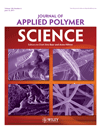Effect of styrene–acrylonitrile on the electrical resistivity of polycarbonate/multiwalled carbon nanotube composites
Abstract
Multiwalled carbon nanotube (MWCNT)-filled polycarbonate (PC)/styrene–acrylonitrile (SAN) blends with a wide range of blend compositions were prepared by melt mixing in a rotational rheometer, and the effect of SAN on the electrical properties of the PC/MWCNT composites was studied. The structure/electrical property relationship was investigated and explained by a combination of MWCNT localization and blend morphology. Transmission electron micrographs showed selective localization of MWCNTs in the PC phase, regardless of the blend morphology. When the SAN concentration was 10–40 wt %, which corresponded to sea-island (10–30 wt %) and cocontinuous (40 wt %) blend morphologies (PC was continuous in both structures), the electrical resistivity decreased with increases in the SAN content. The concept of an effective volume concentration of MWCNTs was used to explain this effect. When the SAN concentration was 70 wt % or higher, the electrical resistivity was very high because MWCNTs were confined in the isolated PC particles. In addition, SAN was replaced by other polymers [polystyrene, methyl methacrylate/styrene, and poly(methyl methacrylate)]; these yielded similar blend morphologies and MWCNT localization and showed the generality of the concept of effective concentration in explaining a decrease in the electrical resistivity upon the addition of a second polymer. © 2011 Wiley Periodicals, Inc. J Appl Polym Sci, 2011.




